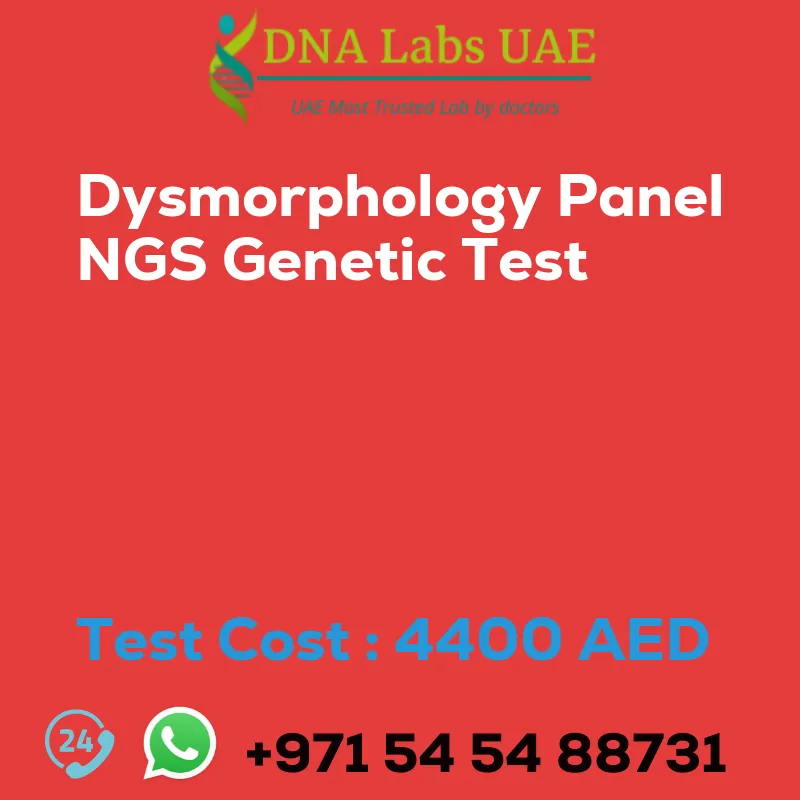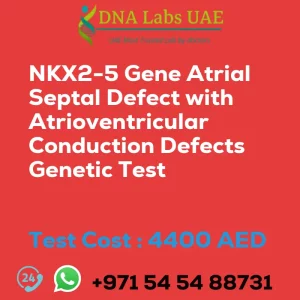Dysmorphology Panel NGS Genetic Test
Test Name: Dysmorphology Panel NGS Genetic DNA Test
Components Price: 4400.0 AED
Sample Condition: Blood or Extracted DNA or One drop Blood on FTA Card
Report Delivery: 3 to 4 Weeks
Method: NGS Technology
Test Type: Dysmorphology
Doctor: Pediatrics
Test Department: Genetics
Pre Test Information: Clinical History of Patient who is going for Dysmorphology Panel NGS Genetic DNA Test. A Genetic Counselling session to draw a pedigree chart of family members affected with various genetic conditions.
Test Details
The Dysmorphology Panel NGS Genetic DNA Test is a type of genetic test that uses next-generation sequencing (NGS) technology to analyze a person’s DNA for mutations and variations that may be associated with physical abnormalities or developmental disorders.
Dysmorphology refers to the study of physical abnormalities or differences in body structure and appearance. These abnormalities can be caused by genetic mutations or environmental factors and can lead to developmental disorders such as intellectual disability, autism spectrum disorder, or congenital malformations.
The Dysmorphology Panel NGS Genetic DNA Test examines a panel of genes that are known to be associated with dysmorphology and developmental disorders. The test can identify mutations or variations in these genes that may contribute to a person’s physical abnormalities or developmental issues.
The test is typically ordered by a healthcare provider or genetic counselor when there is a suspicion of a genetic condition or developmental disorder. Results from the test can help with diagnosis, treatment, and management of the condition.
| Test Name | Dysmorphology Panel NGS Genetic DNA Test |
|---|---|
| Components | |
| Price | 4400.0 AED |
| Sample Condition | Blood or Extracted DNA or One drop Blood on FTA Card |
| Report Delivery | 3 to 4 Weeks |
| Method | NGS Technology |
| Test type | Dysmorphology |
| Doctor | Pediatrics |
| Test Department: | Genetics |
| Pre Test Information | Clinical History of Patient who is going for Dysmorphology Panel NGS Genetic DNA Test. A Genetic Counselling session to draw a pedigree chart of family members affected with ABCB6, ABCC6, ACTA1, ACTA2, ACTB, ACTG1, ACVR2B, ADAMTS2, ADAMTSL2, ADGRG1, AFF4, AGPS, AGRN, AHI1, AKT3, ALDH18A1, ALDH1A3, ALG2, ALPL, AMPD2, ANKH, ANKRD11, ANO5, AP4M1, ARFGEF2, ARHGAP31, ARID1A, ARID1B, ARL13B, ARL6, ARMC4, ARSL, ARX, ASPM, ASXL1, ASXL3, ATP6V0A2, ATP7A, ATR, ATRX, B3GALNT2, B3GALT6, B3GAT3, B4GALT7, B4GAT1, B9D1, B9D2, BBS1, BBS10, BBS12, BBS2, BBS4, BBS5, BBS7, BBS9, BCOR, BGN, BIN1, BMP1, BMP4, BMPR1B, BRAF, C8orf37, CANT1, CASK, CASR, CBL, CBS, CC2D2A, CCDC103, CCDC114, CCDC151, CCDC28B, CCDC39, CCDC40, CCDC65, CCM2, CCNO, CDK5RAP2, CDKN1C, CDON, CENPF, CENPJ, CEP135, CEP152, CEP164, CEP290, CEP41, CEP63, CFAP298, CFAP53, CFC1, CFL2, CHAT, CHD7, CHMP1A, CHRNA1, CHRNB1, CHRND, CHRNE, CHRNG, CHST14, CHSY1, CILK1, CLCN5, COASY, COL10A1, COL11A1, COL11A2, COL12A1, COL1A1, COL1A2, COL2A1, COL3A1, COL4A1, COL5A1, COL5A2, COL6A1, COL6A2, COL6A3, COL9A1, COL9A2, COL9A3, COLQ, COMP, COX7B, CPLANE1, CREB3L1, CREBBP, CRELD1, CRIPT, CRPPA, CRTAP, CSPP1, CUL7, CYP1B1, DAG1, DCX, DDR2, DHCR24, DHCR7, DMP1, DNAAF1, DNAAF2, DNAAF3, DNAAF4, DNAAF5, DNAH11, DNAH5, DNAI1, DNAI2, DNAL1, DNM2, DOK7, DPAGT1, DRC1, DSE, DYM, DYNC1H1, DYNC2H1, DYRK1A, EBP, ECE1, ECEL1, EDN3, EDNRB, EFEMP2, EFNB1, EFTUD2, EGR2, EIF2AK3, ELN, ENPP1, ERCC1, ERCC2, ERCC5, ERCC6, ERF, ESCO2, EVC, EVC2, EXOSC3, FAS, FBLN5, FBN1, FBN2, FGF23, FGF8, FGFR1, FGFR2, FGFR3, FHL1, FKBP10, FKBP14, FKRP, FKTN, FLCN, FLNA, FLNB, FOXC1, FOXE3, FOXH1, FOXL2, FRAS1, FREM1, FREM2, GBA, GBE1, GDF1, GDF3, GDF5, GDF6, GDNF, GFPT1, GJA1, GLE1, GLI2, GLI3, GMPPB, GNAS, GNPAT, GORAB, GRIP1, HCCS, HDAC8, HESX1, HEXA, HMGB3, HMX1, HRAS, HSPG2, HUWE1, HYDIN, HYLS1, IER3IP1, IFITM5, IFT122, IFT140, IFT172, IFT27, IFT43, IFT80, IL11RA, INPP5E, INPPL1, IRF6, ITGB4, KAT6B, KATNB1, KBTBD13, KDM5C, KDM6A, KIF11, KIF2A, KIF5C, KIF7, KIT, KLHL40, KLHL41, KMT2A, KMT2D, KNL1, KRAS, KRIT1, L1CAM, LAMA2, LAMA3, LAMB1, LAMB3, LAMC2, LARGE1, LBR, LEFTY2, LEP, LEPR, LIFR, LMNA, LMOD3, LMX1B, LOX, LRP2, LRP5, LRRC6, LZTFL1, LZTR1, MAB21L2, MAGEL2, MAP2K1, MAP2K2, MASP1, MAT2A, MATN3, MBTPS2, MCPH1, MED12, MED17, MEGF8, MEIS2, MEOX1, MFAP5, MFRP, MFSD2A, MITF, MKKS, MKS1, MMP13, MMP21, MMP9, MSMO1, MSX1, MSX2, MTM1, MUSK, MYBPC1, MYCN, MYH11, MYH2, MYH3, MYH8, MYLK, MYO18B, MYO7A, NAA10, NALCN, NDE1, NDP, NEB, NECTIN1, NEK1, NEK8, NF1, NF2, NHEJ1, NIPBL, NKX2-5, NKX3-2, NME8, NODAL, NOG, NOTCH1, NPHP1, NPHP3, NR0B2, NRAS, NRG1, NSDHL, OCRL, OFD1, ORC1, OTX2, P3H1, PAFAH1B1, PAX2, PAX3, PAX6, PCNT, PDCD10, PDE6D, PEX7, PHC1, PHEX, PHF6, PIEZO2, PIGV, PITX2, PKD1L1, PKD2, PKHD1, PLK4, PLOD1, PLOD2, PMM2, PNKP, PNPLA6, POMC, POMGNT1, POMGNT2, POMK, POMT1, POMT2, POR, PPARG, PPIB, PQBP1, PRDM5, PRKAR1A, PRKG1, PROM1, PRPH2, PRSS56, PTCH1, PTH1R, PTPN11, PYCR1, PYCR2, QARS1, RAB18, RAB23, RAB3GAP1, RAB3GAP2, RAD21, RAF1, RAPSN, RARB, RARS2, RASA1, RASA2, RAX, RBBP8, RBP4, RDH5, RELN, RET, RHO, RIN2, RIT1, RLBP1, ROR2, RPGRIP1L, RPL10, RPS6KA3, RSPH1, RSPH4A, RSPH9, RUNX2, RXYLT1, RYR1, SALL1, SALL2, SALL4, SASS6, SATB2, SBDS, SCN4A, SDCCAG8, SELENON, SEPSECS, SERPINF1, SERPINH1, SHH, SHOC2, SHROOM4, SIX3, SIX6, SKI, SLC25A19, SLC26A2, SLC2A10, SLC34A3, SLC35D1, SLC39A13, SLC5A7, SLC9A6, SMAD2, SMAD3, SMAD4, SMAD6, SMARCA2, SMARCA4, SMARCB1, SMARCE1, SMC1A, SMC3, SMCHD1, SMOC1, SNAI2, SOS1, SOS2, SOX10, SOX2, SOX9, SP7, SPAG1, SPRED1, STAMBP, STIL, STRA6, SUMO1, TAF6, TBC1D20, TBC1D24, TBX5, TCF12, TCF4, TCTN1, TCTN2, TCTN3, TENM3, TFAP2A, TGFB2, TGFB3, TGFBR1, TGFBR2, TGIF1, TK2, TMEM138, TMEM216, TMEM231, TMEM237, TMEM67, TNFRSF11B, TNNI2, TNNT1, TNNT3, TNXB, TOR1A, TP63, TPM2, TPM3, TRIM32, TRIP11, TRMT10A, TRPS1, TRPV4, TSC1, TSC2, TSEN2, TSEN54, TTC21B, TTC8, TUBA1A, TUBA8, TUBB, TUBB2A, TUBB2B, TUBB3, TUBG1, TUBGCP4, TUBGCP6, TWIST1, TYR, UBA1, VAMP1, VIPAS39, VLDLR, VPS13B, VPS53, VRK1, VSX2, WDPCP, WDR19, WDR34, WDR35, WDR60, WDR62, WNT1, WNT5A, WNT7A, YWHAE, ZEB2, ZIC2, ZIC3, ZMYND10, ZNF335, ZNF423, ZNF469 |
| Test Details |
The Dysmorphology Panel NGS Genetic DNA Test is a type of genetic test that uses next-generation sequencing (NGS) technology to analyze a person’s DNA for mutations and variations that may be associated with physical abnormalities or developmental disorders. Dysmorphology refers to the study of physical abnormalities or differences in body structure and appearance. These abnormalities can be caused by genetic mutations or environmental factors, and can lead to developmental disorders such as intellectual disability, autism spectrum disorder, or congenital malformations. The Dysmorphology Panel NGS Genetic DNA Test examines a panel of genes that are known to be associated with dysmorphology and developmental disorders. The test can identify mutations or variations in these genes that may contribute to a person’s physical abnormalities or developmental issues. The test is typically ordered by a healthcare provider or genetic counselor when there is a suspicion of a genetic condition or developmental disorder. Results from the test can help with diagnosis, treatment, and management of the condition. |






